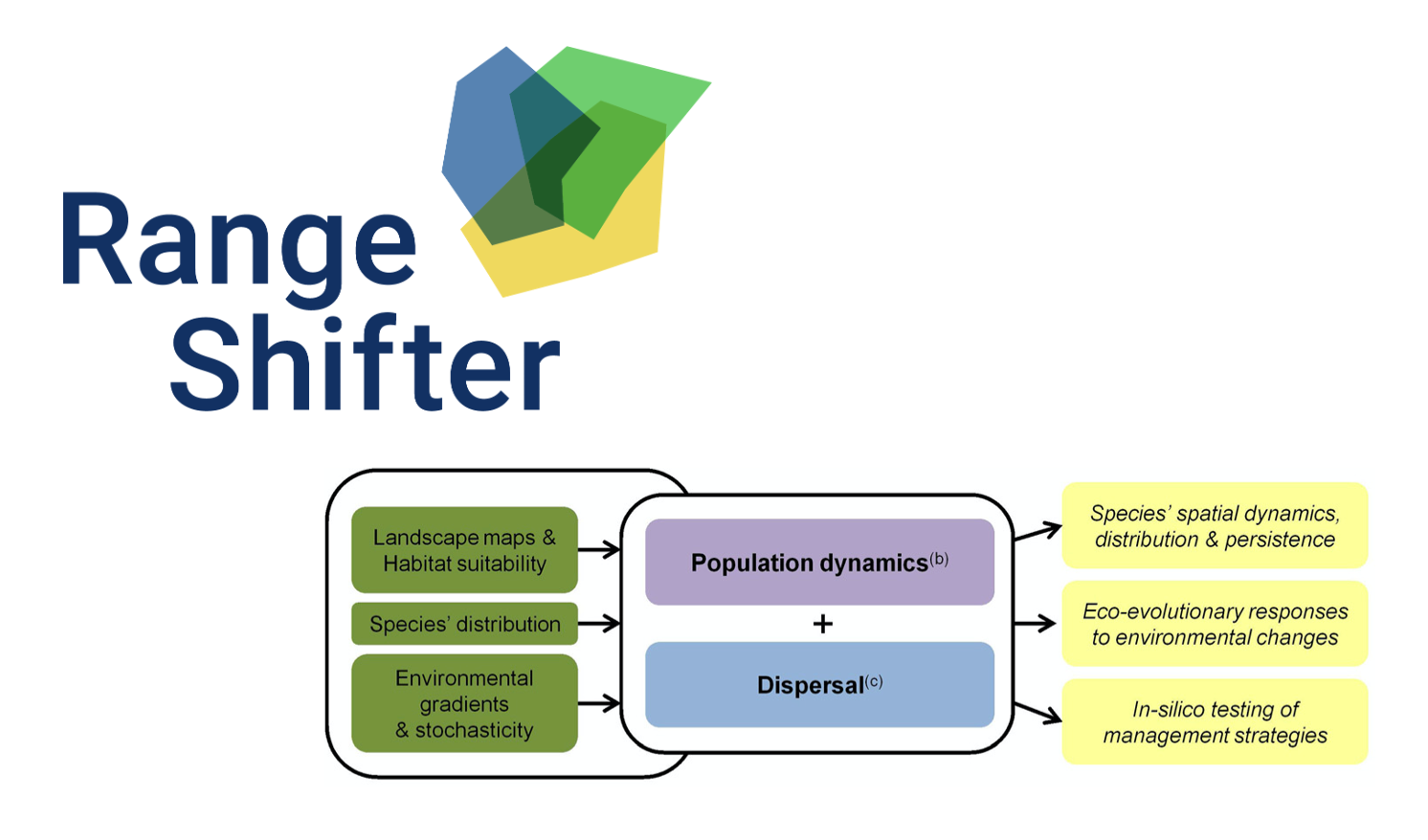As anthropogenic environmental changes accelerate and threaten species’ persistence and associated ecosystem services, major tasks for scientists are to predict biological responses to different and interacting pressures, and to design effective management strategies. Process-based models that explicitly integrate the different processes underpinning the responses of complex biological systems are now increasingly called for and provide opportunities (and challenges) to rapidly move forward in this endeavour (Urban et al. 2016). The RangeShifter software (Bocedi et al. 2014a, 2021) is a state-of-the-art eco-evolutionary modelling platform that is becoming increasingly used worldwide for both theoretical and applied purposes.
RangeShifter is a spatially-explicit, individual-based simulation platform that allows modelling species’ range dynamics, such as expansion and shifting, and patch connectivity by linking complex local population dynamics and dispersal behaviour, while also taking into account inter-individual variability and evolutionary processes. RangeShifter is highly flexible in terms of the spatial resolution and extent, and regarding the complexity of the considered ecological processes. Due to its modular structure, the level of detail in demographic and dispersal processes can be easily adapted to different research questions and available data.
Potential modelling applications are manifold ranging from conservation biogeography to theoretical ecology (e.g. Bocedi et al. 2014b). For example, RangeShifter facilitates predictive modelling of species’ responses to environmental change (e.g. Santini et al. 2016), strategic planning of management interventions and conservation measures (e.g. Aben et al. 2016; Synes et al. 2019), as well as exploring the evolution of dispersal traits during range shifting (e.g. Henry et al. 2014).
The conceptual basis of the RangeShifter platform is summarised in Bocedi et al. (2014a, 2021) and also described in the User manual.
The RangeShifter version 2.0 is available as Windows-GUI and also offers a batch mode (more information here). Additionally, the RangeshiftR package allows running RangeShifter from within the R environment (Malchow et al. 2021). Please browse this website to find out more.
References
- Aben J, Bocedi G, Palmer SCF, Pellikka P, Strubbe D, Hallmann C, Travis JMJ, Lens L, Matthysen E (2016) The importance of realistic dispersal models in conservation planning: application of a novel modelling platform to evaluate management scenarios in an Afrotropical biodiversity hotspot. Journal of Applied Ecology 53: 1055-1065. https://doi.org/10.1111/1365-2664.12643.
- Bocedi G, Palmer SCF, Pe’er G, Heikkinen RK, Matsinos YG, Watts K, Travis JMJ (2014a). RangeShifter: A Platform for Modelling Spatial Eco-Evolutionary Dynamics and Species’ Responses to Environmental Changes. Methods in Ecology and Evolution 5: 388–96. https://doi.org/10.1111/2041-210X.12162.
- Bocedi G, Zurell D, Reineking B, Travis JMJ (2014b) Mechanistic modelling of animal dispersal offers new insights into range expansion dynamics across fragmented landscapes. Ecography 37: 1240-1253. https://doi.org/10.1111/ecog.01041.
- Bocedi G, Palmer SCF, Malchow AK, Zurell D, Watts K, Travis JMJ (2021) RangeShifter 2.0: An extended and enhanced platform for modelling spatial eco-evolutionary dynamics and species’ responses to environmental changes. Ecography. https://doi.org/10.1111/ecog.05687
- Henry RC, Bocedi G, Dytham C, Travis JMJ (2014) Inter-annual variability influences the eco-evolutionary dynamics of range-shifting. PeerJ 1:e228. https://dx.doi.org/10.7717%2Fpeerj.228.
- Malchow AK, Bocedi G, Palmer SCF, Travis JMJ, Zurell D (2021) RangeShiftR: an R package for individual-based simulation of spatial eco-evolutionary dynamics and species’ responses to environmental changes. Ecography. https://doi.org/10.1111/ecog.05689.
- Santini L, Cornulier T, Bullock JM, Palmer SCF, White SM, Hodgson JA, Bocedi G, Travis JMJ (2016) A trait‐based approach for predicting species responses to environmental change from sparse data: how well might terrestrial mammals track climate change?. Global Change Biology 22: 2415-2424. https://doi.org/10.1111/gcb.13271.
- Synes NW, Brown C, Palmer SCF, Bocedi G, Osborne PE, Watts K, Franklin J, Travis JMJ (2019) Coupled land use and ecological models reveal emergence and feedbacks in socio‐ecological systems. Ecography 42: 814-825. https://doi.org/10.1111/ecog.04039.
- Urban MC, Bocedi G, Hendry AP, Mihoub JB, Pe’er G, Singer A, Bridle JR, et al. (2016) Improving the Forecast for Biodiversity Under Climate Change. Science 353: aad8466. https://doi.org/10.1126/science.aad8466.
